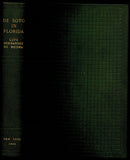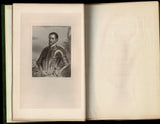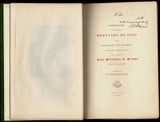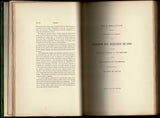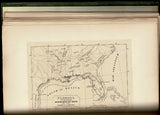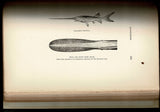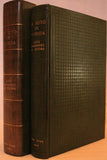Narratives of the career of Hernando de Soto in the conquest of Florida, as told by a knight of Elvas; and in a relation by Luys Hernandez de Biedma, factor of the expedition
Author: Knight of Elvas and Luis Hernández de Biedma (16th century) edited by Edward Gaylord Bourne
Year: 1866
Publisher: Bradford Book Club
Place: New York
Description:
xiii+324 pages with frontispiece, maps, plates, illustrations, appendix and index. Quarto (10 3/4" x 7 1/4") bound in green cloth with gilt lettering to spine housed in custom enclosure. Translated by Buckingham Smith. Edited by Edward Gaylord Bourne. Bradford Club Series number 5. First edition limited to 125 copies of which this is number 76.
Hernando de Soto (c1500-1542) was a Spanish explorer and conquistador who was involved in expeditions in Nicaragua and the Yucatan Peninsula. He played an important role in Francisco Pizarro's conquest of the Inca Empire in Peru, but is best known for leading the first European expedition deep into the territory of the modern-day United States (through Florida, Georgia, Alabama, Mississippi, and most likely Arkansas). He is the first European documented as having crossed the Mississippi River.
De Soto's North American expedition was a vast undertaking. It ranged throughout what is now the southeastern United States, both searching for gold, which had been reported by various Native American tribes and earlier coastal explorers, and for a passage to China or the Pacific coast. De Soto died in 1542 on the banks of the Mississippi River; different sources disagree on the exact location, whether it was what is now Lake Village, Arkansas, or Ferriday, Louisiana.
In May 1539, de Soto landed nine ships with over 620 men and 220 horses in an area generally identified as south Tampa Bay. The ships carried priests, craftsmen, engineers, farmers, and merchants; some with their families, some from Cuba, most from Europe and Africa. The expedition traveled north, exploring Florida's West Coast, and encountering native ambushes and conflicts along the way. Hernando de Soto army seized the food stored in the villages, captured women to be used as slaves for the soldiers sexual gratification, and forced men and boys to serve as guides and bearers. The army fought two battles with Timucua groups, resulting in heavy Timucua casualties. After defeating the resisting Timucuan warriors, Hernando de Soto had 200 executed, in what was to be called the Napituca Massacre, the first large-scale massacre by Europeans in the current United States. De Soto's first winter encampment was at Anhaica, the capital of the Apalachee people. It is one of the few places on the route where archaeologists have found physical traces of the expedition. The chroniclers described this settlement as being near the "Bay of Horses". The bay was named for events of the 1527 Narváez expedition, the members of which, dying of starvation, killed and ate their horses while building boats for escape by the Gulf of Mexico.
Condition:
Previous owner's inscription to title else better than very good in a custom enclosure.











